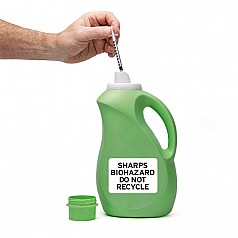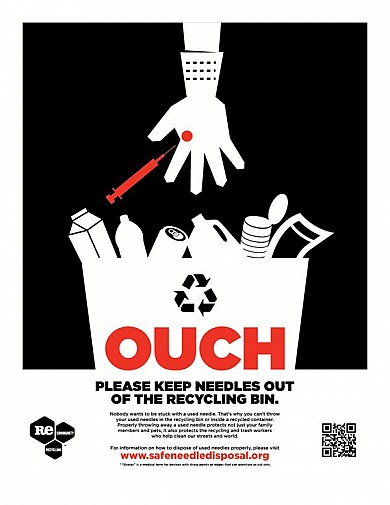September 11, 2018
Today’s article was originally written by Catherine Ardoin, Communications Manager for the Environmental Research and Education Foundation (EREF). It was originally posted on the EREF website on August 28, 2018.
Results found in a groundbreaking new report from the Environmental Research & Education Foundation (EREF), in collaboration with the Solid Waste Association of North America (SWANA), indicate a needlestick injury rate at material recovery facilities (MRFs) of 2.7 per 100 workers. According to U.S. Bureau of Labor Statistics’ (BLS) 2016 data, MRF injuries (including non-needlestick related) occur at a rate of 6 per 100 workers, suggesting 45 percent of MRF injuries could be attributed to needlesticks.
This first-of-its-kind study surveyed MRF owners on needlestick occurrences at their facilities, an area in which little data exists. The survey, initiated online with follow-up calls and e-mails for additional information, includes responses from 35 MRFs across the U.S. and Canada. Fifty-three percent of these facilities noted having simply observed needles daily or a few times per week. Over half of the facilities observed them mixed with plastics. Due to their direct contact with waste material, MRF picking line workers experienced the highest number of incidences at a rate of 3.9 per 100 workers.
“MRFs across the U.S. are working to decrease contamination in order to meet China’s new standards, putting more pressure on picking line workers to remove contamination and increasing the possibility of injury,” said Bryan Staley, EREF CEO and President. “Given the limited data available on needlesticks, this study aims to inform discussions and decision making related to worker safety.”
Based on EREF findings, it is estimated that between 781 and 1,484 needlestick injuries may occur each year at U.S. MRFs. These injuries could result in up to $2.25M in direct costs for treatment, prophylaxis and patient monitoring.
 “SWANA was pleased to work with EREF on this important study, as needlesticks are a growing occupational hazard at MRFs and other solid waste facilities,” stated David Biderman, SWANA’s CEO and Executive Director. “We look forward to working on additional projects with EREF in the near future.”
“SWANA was pleased to work with EREF on this important study, as needlesticks are a growing occupational hazard at MRFs and other solid waste facilities,” stated David Biderman, SWANA’s CEO and Executive Director. “We look forward to working on additional projects with EREF in the near future.”
Seventy-five percent of survey respondents state that needlestick incidences are very important compared to other risks. MRFs identified several strategies to reduce needlestick injuries, including written protocols, the use of personal protective equipment, changes in operations or equipment to manage the hazard, reinforcement of reporting and facility and community education.
While policies and guidance exist to regulate household sharps disposal, these policies vary from state to state. Forty-six states, excluding California, Massachusetts, Oregon and Wisconsin, allow for sharps disposal in household trash, provided it is contained in a properly labeled, rigid container. Other suggested disposal methods aim to eliminate needles from the municipal solid waste stream altogether.
They include community drop-off sites, mail-back and syringe exchange programs and residential special waste pickup services.
The mission of Environmental Research and Education Foundation is to fund and direct scientific research and educational initiatives for waste management practices to benefit industry participants and the communities they serve. The article was reposted by permission.
To access the free Household Needles in Municipal Solid Waste (MSW) Report (PDF), click here.




Comments (0)
Add a Comment